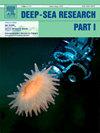What do glass sponges do when no one is looking? Vazella pourtalesii: Responses to sediment deposition, passive locomotion, and contracting behavior
IF 2.1
3区 地球科学
Q2 OCEANOGRAPHY
Deep-Sea Research Part I-Oceanographic Research Papers
Pub Date : 2024-08-29
DOI:10.1016/j.dsr.2024.104388
引用次数: 0
Abstract
Behavioral response of deep-sea sponges can provide crucial insights into the mechanisms shaping energy fluxes and ecosystem functioning. Although some advances have been made, the behavior of deep-sea Hexactinellid still remain widely unknown. In the present study we address the glass sponge Vazella pourtalesii behavior. High-temporal resolution imaging and environmental data were acquired with an autonomous lander deployed in the Sambro Bank Sponge Conservation Area (Scotian Shelf) at a depth of 150 m, representing the upper limit of this deep-sea species' distribution and what is commonly regarded as the deep sea.
For 94 days, a V. pourtalesii individual was monitored, providing quantitative information on its response to sediment deposition triggered by a storm, as well as on its passive locomotion and contractive behavior. Sediment was cleared from its surface within 72 h, which is highly relevant for its filtering capacity, indicating that this sponge species can cope with high suspended sediment concentrations. This enables it to occur on sedimentary environments like the Scotian Shelf. As observed in other deep-sea hexactinellids, the monitored individual engaged in rhythmic contractions, which appear to be driven by physiological process/es rather than environmental factors. During the study period, strong bottom currents (>37 cm/s) toppled and displaced the monitored individual several times. Despite changes in position and orientation that can negatively impact the filtering capacity of sponges, no signs of deterioration were observed. V. pourtalesii's vase-like body morphology and attachment to cobbles, as a gravitational center, may allow it to have a more homogeneous interaction with currents which may permit them to better cope with positional changes. Overall, this study highlights that deep-sea Porifera display a wide array of phenological changes in response to both biotic and abiotic factors.
玻璃海绵会趁人不注意时做什么?Vazella pourtalesii:对沉积物沉积、被动运动和收缩行为的反应
深海海绵的行为反应可以为了解能量通量和生态系统功能的形成机制提供重要信息。尽管已经取得了一些进展,但深海六带栉水母的行为仍然广为人知。在本研究中,我们探讨了玻璃海绵 Vazella pourtalesii 的行为。自主着陆器部署在水深 150 米的桑布罗岸海绵保护区(苏格兰大陆架),代表了该深海物种分布的上限,也是通常认为的深海。其表面的沉积物在 72 小时内被清除,这与它的过滤能力密切相关,表明这种海绵可以应对高浓度的悬浮沉积物。这使它能够出现在像斯科舍大陆架这样的沉积环境中。与在其他深海六线螺旋藻中观察到的情况一样,被监测的个体进行有节律的收缩,这似乎是由生理过程而不是环境因素驱动的。在研究期间,强烈的底流(37 厘米/秒)多次使被监测个体翻转和移位。尽管位置和方向的变化会对海绵的过滤能力产生负面影响,但没有观察到任何退化的迹象。V. pourtalesii 的花瓶状身体形态和附着在鹅卵石上的重力中心,可能使其与水流的相互作用更加均匀,从而使其能够更好地应对位置变化。总之,这项研究突出表明,深海多孔动物在生物和非生物因素的作用下,会出现各种各样的物候变化。
本文章由计算机程序翻译,如有差异,请以英文原文为准。
求助全文
约1分钟内获得全文
求助全文
来源期刊
CiteScore
4.60
自引率
4.20%
发文量
144
审稿时长
18.3 weeks
期刊介绍:
Deep-Sea Research Part I: Oceanographic Research Papers is devoted to the publication of the results of original scientific research, including theoretical work of evident oceanographic applicability; and the solution of instrumental or methodological problems with evidence of successful use. The journal is distinguished by its interdisciplinary nature and its breadth, covering the geological, physical, chemical and biological aspects of the ocean and its boundaries with the sea floor and the atmosphere. In addition to regular "Research Papers" and "Instruments and Methods" papers, briefer communications may be published as "Notes". Supplemental matter, such as extensive data tables or graphs and multimedia content, may be published as electronic appendices.

 求助内容:
求助内容: 应助结果提醒方式:
应助结果提醒方式:


